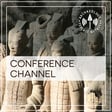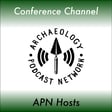Become a Creator today!Start creating today - Share your story with the world!
Start for free
00:00:00
00:00:01

059 - CIFA2018 - Dr. Chrys Harris
Dr. Chrys Harris talks to me about her company Magnitude Surveys, outlining the different techniques they provide to business. She explains Electromagnetic surveys as well as telling me about the archaeology in and around Bradford where Magnitude Surveys is based.
This was recorded at CIFA Brighton 2018 conference
http://www.magnitudesurveys.co.uk/
twitter.com/MagSurveys
Recommended
Transcript
Kickoff at Archaeology Conference
00:00:01
Speaker
You're listening to the Archaeology Podcast Network.
00:00:20
Speaker
Awesome. So you've got a nice little booth here. Um, what have you got at your booth to offer us? Apart from obviously the services provide by magnitude surveys, but what's the swag? Uh, we have flash drives, we have pens, we have notepads. Um, we have scale rulers, flyers, and mostly suddenly cupcakes.
00:00:45
Speaker
cupcakes, right. So what's been, what would you, if you were at this conference, not for Magnitude Survey, what kind of stuff, what kind of swag do you usually look out for? I usually go for pens and flash drives. Be the two top things I go for. I'm not really into sweets, pens, you always need more pens. Yeah, yeah, that's pretty true, pretty true. So we'll get the boring stuff out of the way. What does Magnitude Survey do?
Introduction to Magnitude Survey Services
00:01:15
Speaker
We are an independent provider of archaeological geophysics surveys to the commercial, community and public outreach sectors. We're based in Bradford, but we work anywhere, everywhere. Everywhere. Good, good, good.
Game and Survey Strategy Discussion
00:01:30
Speaker
And you were kind of just running through a little game with me earlier that actually had a point. So obviously it was like you got more and more parts of a map
00:01:41
Speaker
with geophys done on it. And you had to guess what it was before you got all the maps. So what was the thought behind that game? Quite often, we do quotes for we have the entire large site. And then it goes, oh, we don't want to necessarily pay to do geophysics over the entire area. Can we do smaller targeted areas? Which means we're doing sometimes
00:02:11
Speaker
narrow linear corridors or discrete blocks around the site and often it makes it harder to interpret the results because it's always useful to have more context especially when you have if you have like a linear anomaly just running through somewhere what that could be produced by a lot of things so having more coverage can give you a better idea of what's going on and what's the nature of the surrounding landscape.
00:02:37
Speaker
So obviously technology is a very big part of commercial archaeology and archaeology in general and I've always found it quite interesting how archaeology seems to be sometimes the pioneers of kind of new techniques and everything. How long have you worked for managed surveys?
Founder’s Insights into Geophysics
00:02:55
Speaker
I'm one of the founders of magnitude. We set up nearly three years ago. My other directors come from backgrounds working in, both have academic degrees and postgraduate degrees in archaeological geophysics, but worked for commercial units.
00:03:17
Speaker
but I came from a pure academic background. So this is probably my first exposure into working more in the commercial world versus the academic world. Do you have a favourite type of geophys that you like doing personally or you don't really get the hands dirty or something?
Techniques in Electromagnetic Induction
00:03:35
Speaker
I did my PhD in electromagnetic induction methods. So I get really excited when
00:03:43
Speaker
people ask about doing those. They're becoming more interested in doing EM surveys because they can measure to different soil properties simultaneously and you get multiple depth information and some of the bigger systems for doing. A big thing now is paleo landscapes. So we have a big ongoing project, actually several ongoing projects where we're taking one of the big
00:04:09
Speaker
It's about several meter long sensors to map with paleo channels and then having the main automatry with it. So you get a nice like different complementary data sets to go with that.
00:04:20
Speaker
Now, I have a little bit of background in chemistry, so science stuff really kind of, you know, gets the light bulb going. What? So you were talking about EM surveys doing different soil properties and depths. When we're talking about different soil properties simultaneously, what are we talking about? Like, what are you measuring? So I think the standard, when people think of
00:04:44
Speaker
When people think of geophysics, they usually think of a magnetometer survey, and that essentially is just measuring magnetic changes, whereas electromagnetic induction surveys, it measures magnetic acceptability, which is a specific component, like specific magnetic properties, and also
00:05:05
Speaker
electrical conductivity, so how easy it is to induce current flow into the ground. So magnetometers are great for picking up magnetic enhancement, which all sorts of anthropogenic and archaeological activity produces magnetic enhancement, whereas the EM surveys with the electrical conductivity is good for
00:05:25
Speaker
differences in soil density and texture. And you were talking about paleo soils. How deep do you have to go to be considered the paleo landscape? What is the definition there?
Exploring Paleo Landscape Surveys
00:05:40
Speaker
Because obviously
00:05:42
Speaker
You know, when we talk about studying the past generally, you know, you're talking about fines just under the soil for anthropogenic fines. So what is paleo soil? What is paleo fines and paleo landscape? The service that we have
00:06:00
Speaker
They have very good briefs, and I say this is the key part of this, a very well-defined brief for what they're doing for this survey. So they wanted to find paleo landscapes, features that are maybe more, or sites that are more ephemeral, that are more difficult to find with traditional survey methods. So going and mapping old
00:06:26
Speaker
geological landforms, I think, to target where there would be more likelihoods to have these sites. So we're not necessarily looking for archaeological features for themselves, but areas to target. Do you come to a lot of conferences? How do you find this one? How do you find SIFA as conferences?
Experiences as a Conference Exhibitor
00:06:43
Speaker
This is my first time at SIFA. This is my first time at a conference not presenting. This is my first time at a conference as an exhibitor. So it's been, it's a very different experience, I think, being an exhibitor versus presenting. Yeah, no, no, I completely appreciate that. Is this your first time in Brighton? It's my first time in Brighton. It's my first in Brighton. What do you think of Brighton?
00:07:11
Speaker
It's bigger than I was expecting. OK, OK. And windier. Well, it is on the sea. And I personally quite like the seaside. I do like to be beside the sea. What about yourself? It's a bit of a novelty to me. Because to my knowledge, Bradford is pretty much not near the sea.
00:07:32
Speaker
You know, less than two hours or an hour, either way, east or west. That's really, that is really as far from the seeds you can get in England, I believe. Well, I'm also from, I'm from Minnesota in the US and it's not very far from the geographic center of North America. So also where I grew up is as far as you can get. So I think it's a novel.
Impressions of Brighton
00:07:58
Speaker
It has a certain novelty to me, but it has this uneasiness as well. I'm much more content with lakes and Forests personally have you seen the pier and the Brighton pier and everything I saw that time the the promenade I
00:08:14
Speaker
Yeah, we're not on the pier the first night. It's very windy. There is a lot of, it reminded me of like American carnival rides. It's very, it was massive. It's very what I was expecting. Crazy. And yeah, but I find it was really interesting if you go along a little bit. There's also the remains of the other pier, which I thought was, it looks a bit odd standing out there. I don't know if you saw it.
00:08:39
Speaker
Oh yeah, or the dinner was overlooked last night. The decaying and I don't want to say corpse, but it literally reminds me of this thing at sea. I thought that was really interesting and a really weird kind of aspect of built heritage right in the middle of Brighton. I wonder if it was chosen for that. All the archaeologists look out and see that. Interesting.
00:09:05
Speaker
kind of reminded me of Brantford in some ways since we have a lot of those kind of empty old Victorian mill buildings that are kind of some of them are developed around them but some of them are there just kind of waiting for either to be redeveloped or a lot of them go up in flames.
Community Archaeology in Bradford
00:09:23
Speaker
Yeah, it is a shame, you know, when you see these buildings fall into disrepair rather than, you know, something happened with them. I was listening to one of the things upstairs where they're talking about a lot of the time we do too much archaeology in the sense that it doesn't really, like, you know,
00:09:45
Speaker
There's not really a community involvement in that. How is archaeology in Bradford? Like, obviously you guys work nationally, you supply everybody with stuff. Do you ever get involved with stuff that happens around Bradford?
00:10:01
Speaker
I think one of the most successful community and public engagement projects I've seen, it was when I was doing my PhD and my supervisor, Chris Gaffney, did, at first it was a geophysical survey and then developed into a larger project at the old Bradford Football Park. So they went and mapped all of the area. I think they did radar, they did res, and then they excavated and brought in the local neighborhoods.
00:10:30
Speaker
and dug out all of the old aspects of the football ground. And people loved it because it was, I really had a fond spot in someone's living memory and had a good sense of kind of community connection to it. I found that a lot only we're going out to Lister Park, which is a big Victorian park in Bradford. And there is a
00:10:54
Speaker
swimming pool that was built in the early 20th century that was kind of demolished in the 1970s. So we'd always go out there and do training out there. And people just loved going and hearing what we're doing and seeing some of the results because they just have that connection to that place. And that's the kind of archaeology that, you know, what we've been exposed to in Bradford is more recent or industrial archaeology, which people, I think, connect with really well.
00:11:24
Speaker
That's really cool.
Connecting with Magnitude Survey
00:11:25
Speaker
If people want to kind of get in contact with you about doing geofiz, what's the best way to find you guys? Probably the best way is just to send an email to info at magnitudesurveys.co.uk or give us a ring, 01274 926020. We're on Twitter as well, you can tweet us. But email's probably the best.
00:12:16
Speaker
No worries. Thank you very much. Thank you.

